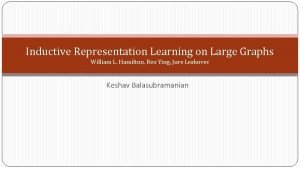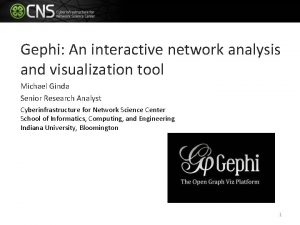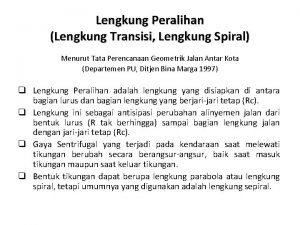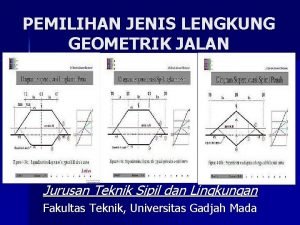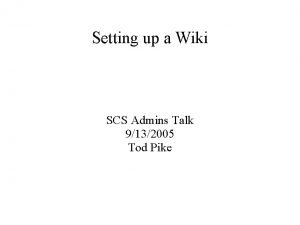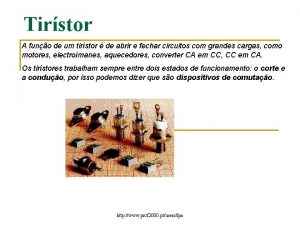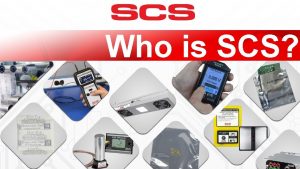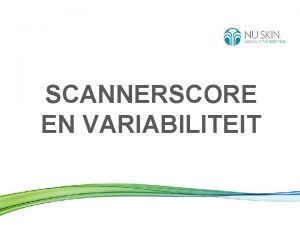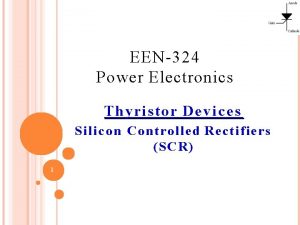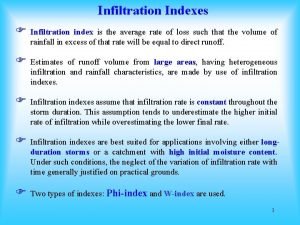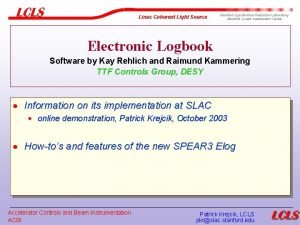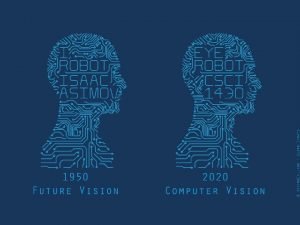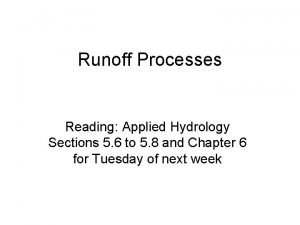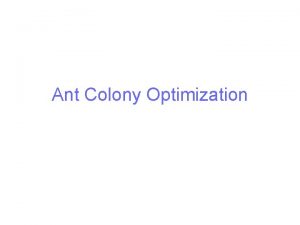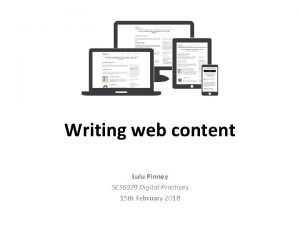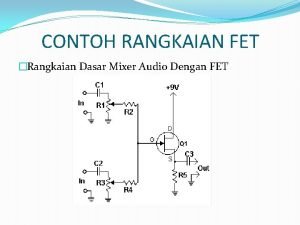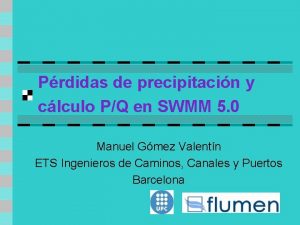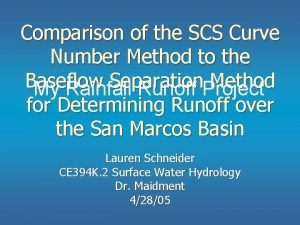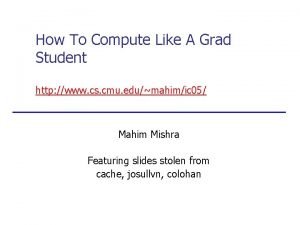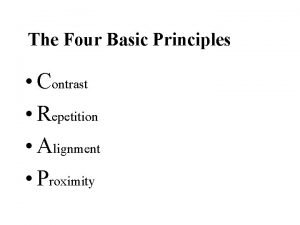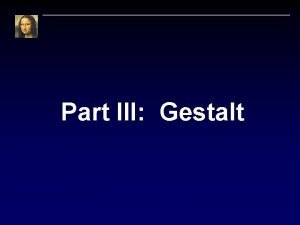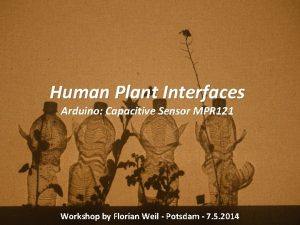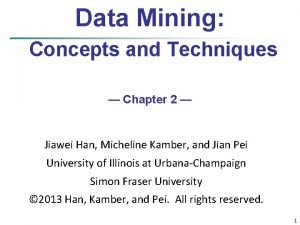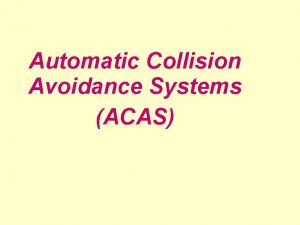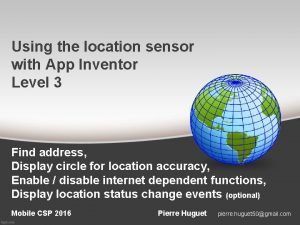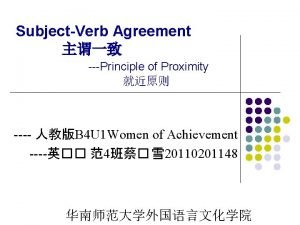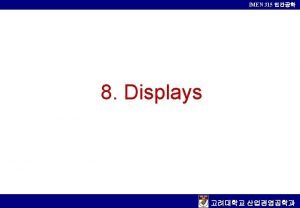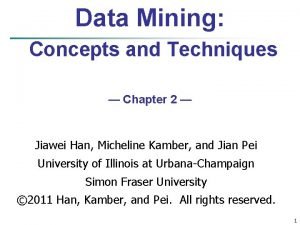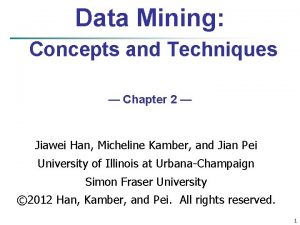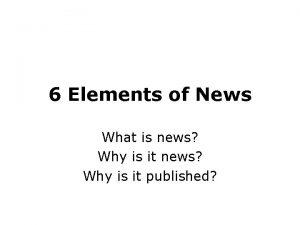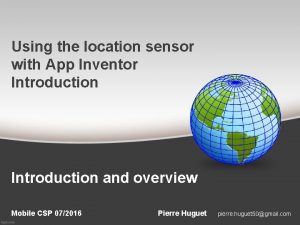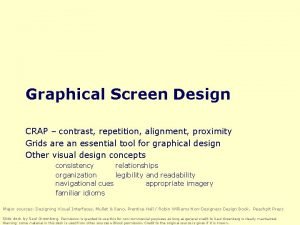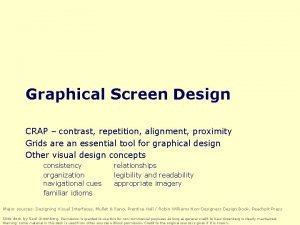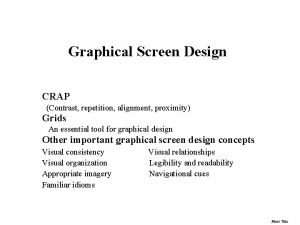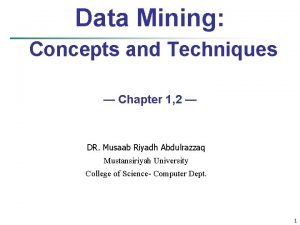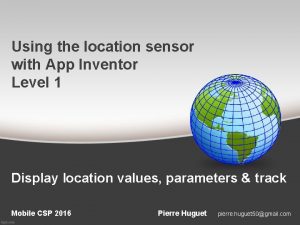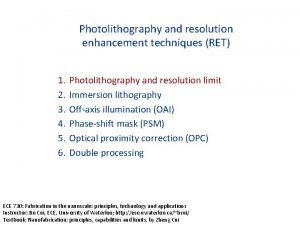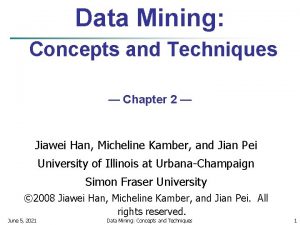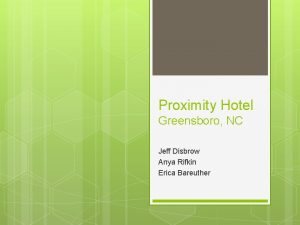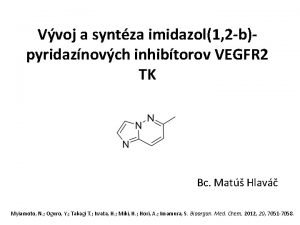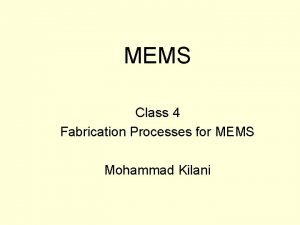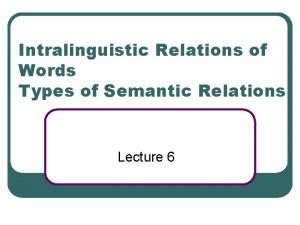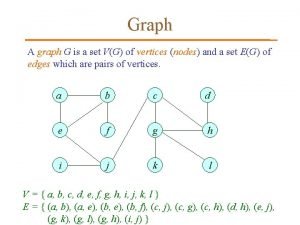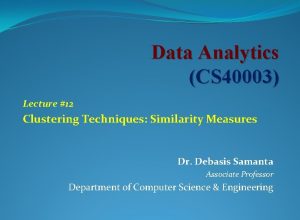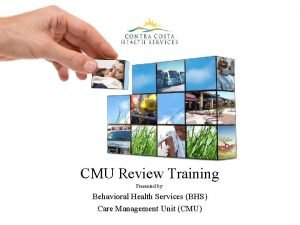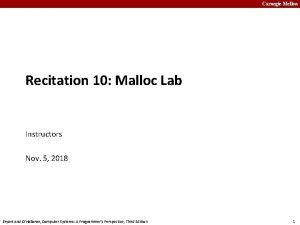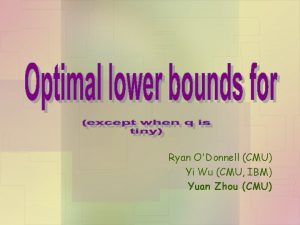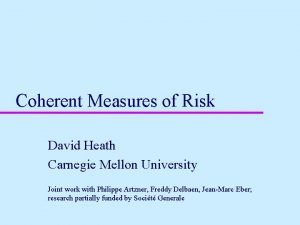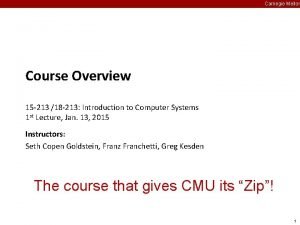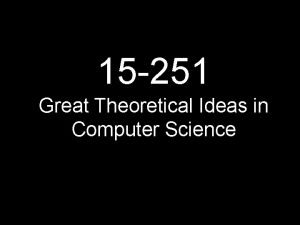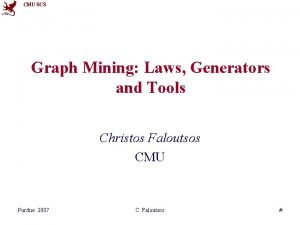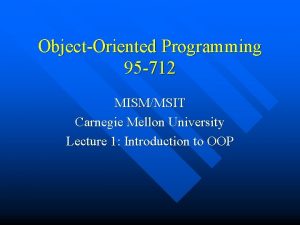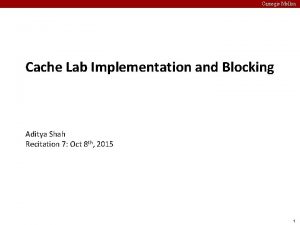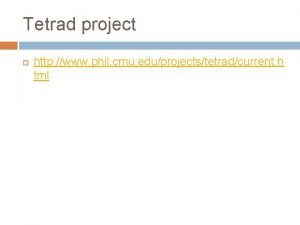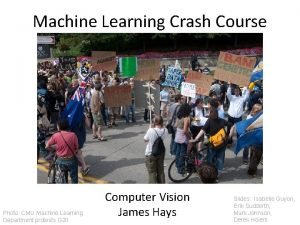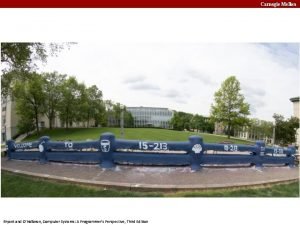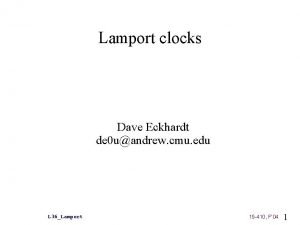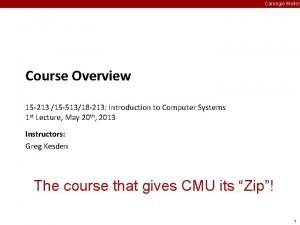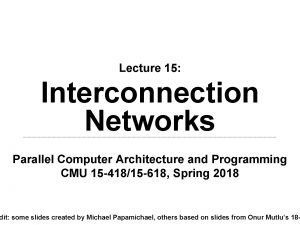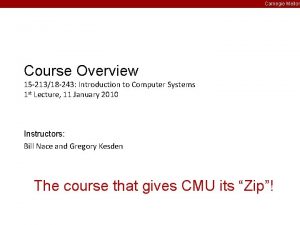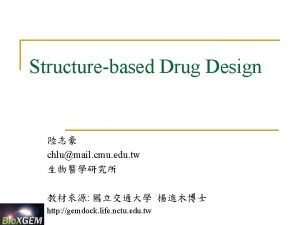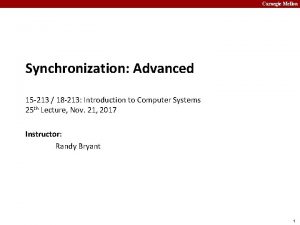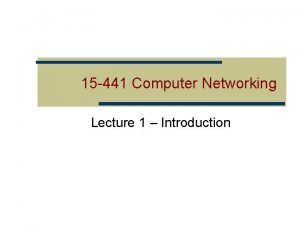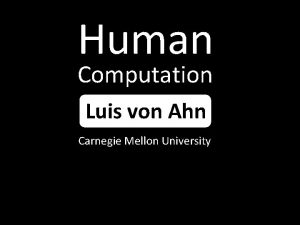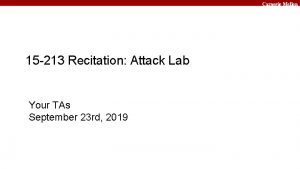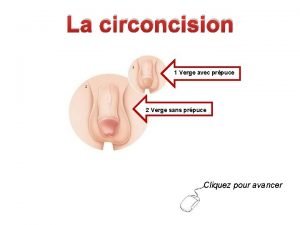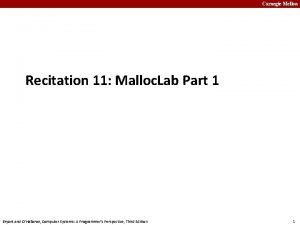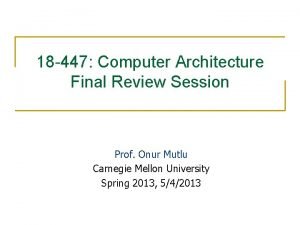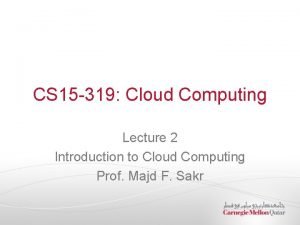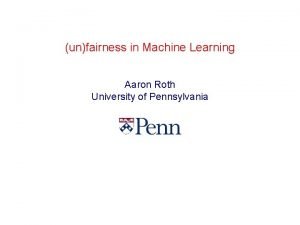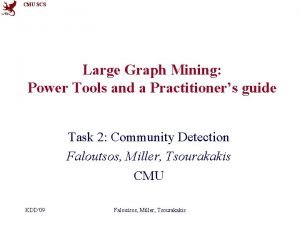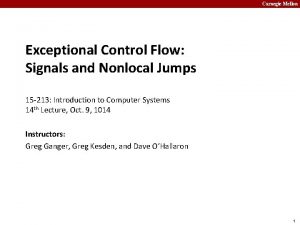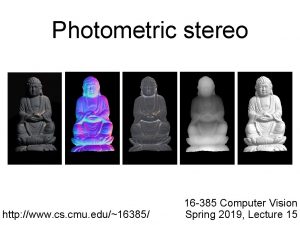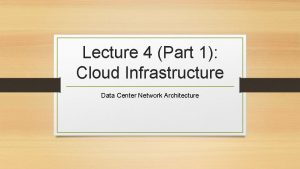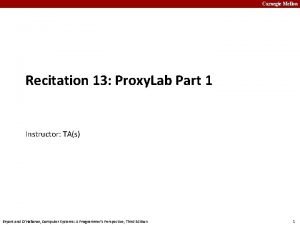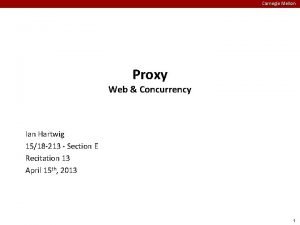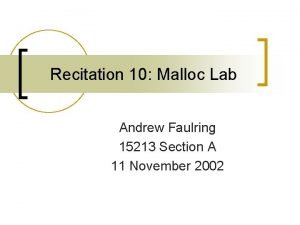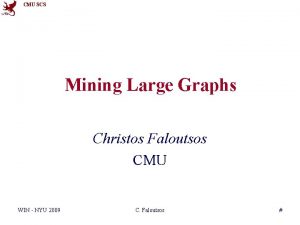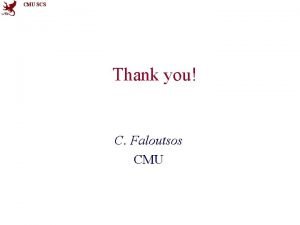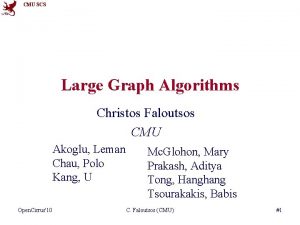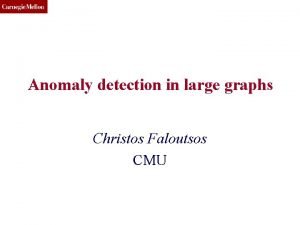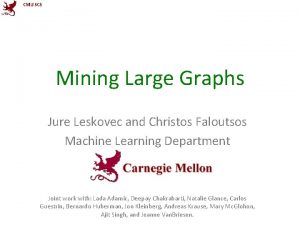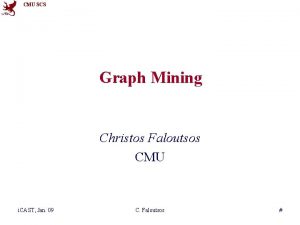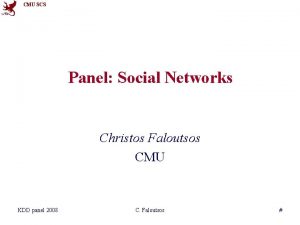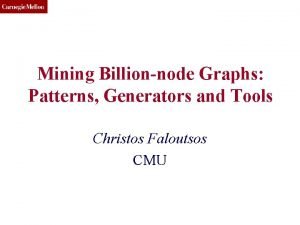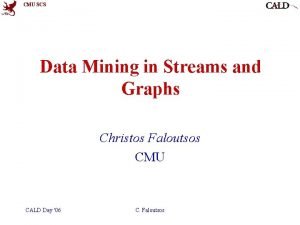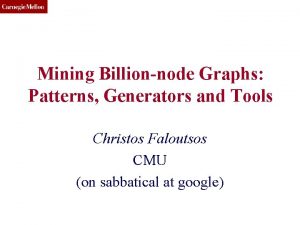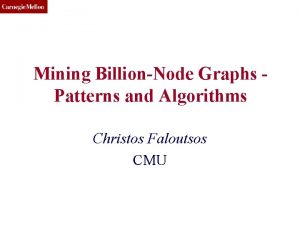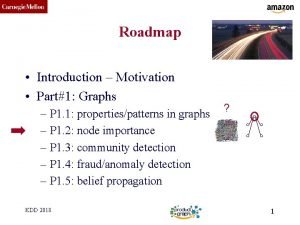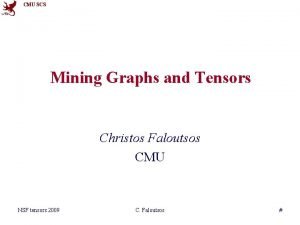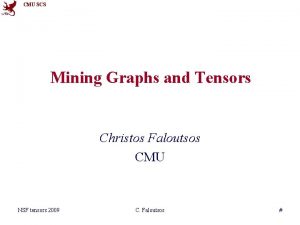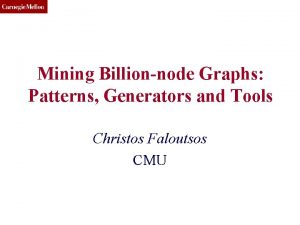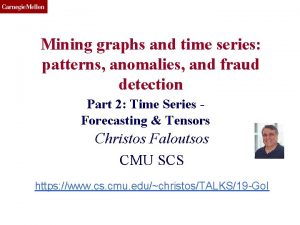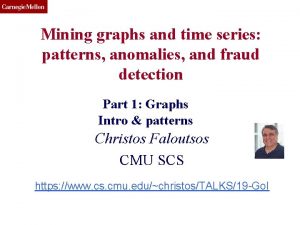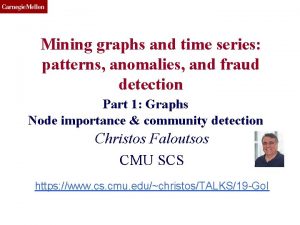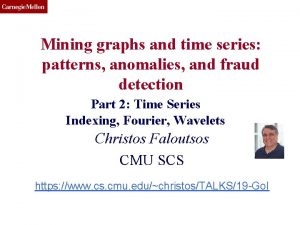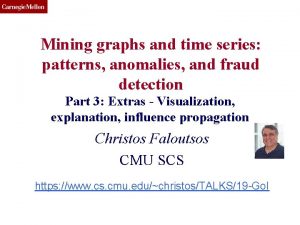SCS CMU Proximity on Large Graphs Speaker Hanghang




![SCS CMU Proximity is the main tool behind… • • • Link prediction [Liben-Nowell+], SCS CMU Proximity is the main tool behind… • • • Link prediction [Liben-Nowell+],](https://slidetodoc.com/presentation_image_h2/85f3826103ad1e16b82426f6fbfdd919/image-5.jpg)









![SCS CMU Other Variants • Other measure by RWs – Community Time/Hitting Time [Fouss+] SCS CMU Other Variants • Other measure by RWs – Community Time/Hitting Time [Fouss+]](https://slidetodoc.com/presentation_image_h2/85f3826103ad1e16b82426f6fbfdd919/image-15.jpg)
![SCS CMU Other Variants • Other measure by RWs – Community Time/Hitting Time [Fouss+] SCS CMU Other Variants • Other measure by RWs – Community Time/Hitting Time [Fouss+]](https://slidetodoc.com/presentation_image_h2/85f3826103ad1e16b82426f6fbfdd919/image-16.jpg)

![SCS CMU Asymmetry of Proximity [Tong+ KDD 07 a] What is Prox between A SCS CMU Asymmetry of Proximity [Tong+ KDD 07 a] What is Prox between A](https://slidetodoc.com/presentation_image_h2/85f3826103ad1e16b82426f6fbfdd919/image-18.jpg)


![SCS CMU Group Proximity [Tong+ 2007] • Q: How close are Accountants to SECs? SCS CMU Group Proximity [Tong+ 2007] • Q: How close are Accountants to SECs?](https://slidetodoc.com/presentation_image_h2/85f3826103ad1e16b82426f6fbfdd919/image-21.jpg)


![SCS CMU skip Attributes on nodes/edges (ER graph) [Chakrabarti+ WWW 07] Works Wrote Sent SCS CMU skip Attributes on nodes/edges (ER graph) [Chakrabarti+ WWW 07] Works Wrote Sent](https://slidetodoc.com/presentation_image_h2/85f3826103ad1e16b82426f6fbfdd919/image-24.jpg)
![SCS CMU Proximity w/ Time • Sol #1: treat time an categorical attr. [Minkov+] SCS CMU Proximity w/ Time • Sol #1: treat time an categorical attr. [Minkov+]](https://slidetodoc.com/presentation_image_h2/85f3826103ad1e16b82426f6fbfdd919/image-25.jpg)





![SCS CMU Beyond RWR : Maxwell Equation for Web! [Chakrabarti] SM Learning RL in SCS CMU Beyond RWR : Maxwell Equation for Web! [Chakrabarti] SM Learning RL in](https://slidetodoc.com/presentation_image_h2/85f3826103ad1e16b82426f6fbfdd919/image-31.jpg)






![B_Lin: Basic Idea [Tong+] 9 10 SCS CMU Find Community 2 1 4 9 B_Lin: Basic Idea [Tong+] 9 10 SCS CMU Find Community 2 1 4 9](https://slidetodoc.com/presentation_image_h2/85f3826103ad1e16b82426f6fbfdd919/image-38.jpg)

















![SCS CMU Fast. All. DAP [Tong+] • Q: How to compute – Esc_Prob = SCS CMU Fast. All. DAP [Tong+] • Q: How to compute – Esc_Prob =](https://slidetodoc.com/presentation_image_h2/85f3826103ad1e16b82426f6fbfdd919/image-56.jpg)












![SCS CMU BB_Lin: Pre-Computation [Tong+ 06] 2 -step RWR for Conferences • Step 1: SCS CMU BB_Lin: Pre-Computation [Tong+ 06] 2 -step RWR for Conferences • Step 1:](https://slidetodoc.com/presentation_image_h2/85f3826103ad1e16b82426f6fbfdd919/image-69.jpg)
![SCS CMU BB_Lin: Pre-Computation [Tong+ 06] 2 -step RWR for Conferences • Step 1: SCS CMU BB_Lin: Pre-Computation [Tong+ 06] 2 -step RWR for Conferences • Step 1:](https://slidetodoc.com/presentation_image_h2/85f3826103ad1e16b82426f6fbfdd919/image-70.jpg)
![SCS CMU BB_Lin: Pre-Computation [Tong+ 06] 2 -step RWR for Conferences • Step 1: SCS CMU BB_Lin: Pre-Computation [Tong+ 06] 2 -step RWR for Conferences • Step 1:](https://slidetodoc.com/presentation_image_h2/85f3826103ad1e16b82426f6fbfdd919/image-71.jpg)








![SCS CMU Update : General Case [Tong+ 2008] n authors ~M = Ac X SCS CMU Update : General Case [Tong+ 2008] n authors ~M = Ac X](https://slidetodoc.com/presentation_image_h2/85f3826103ad1e16b82426f6fbfdd919/image-80.jpg)























![SCS CMU Author A’ Rank in KDD p. Track • [Given] – (1) a SCS CMU Author A’ Rank in KDD p. Track • [Given] – (1) a](https://slidetodoc.com/presentation_image_h2/85f3826103ad1e16b82426f6fbfdd919/image-104.jpg)


![SCS CMU c. Track • [Given] – (1) a large, skewed time-evolving graphs, – SCS CMU c. Track • [Given] – (1) a large, skewed time-evolving graphs, –](https://slidetodoc.com/presentation_image_h2/85f3826103ad1e16b82426f6fbfdd919/image-107.jpg)








- Slides: 115

SCS CMU Proximity on Large Graphs Speaker: Hanghang Tong 2008 -4 -10 15 -826 Guest Lecture

SCS CMU Graphs are everywhere! 2

SCS CMU Graph Mining: the big picture Graph/Global Level Subgraph/ Community Level Node Level We are here! 4

SCS CMU Proximity on Graph: What? a. k. a Relevance, Closeness, ‘Similarity’… 5
![SCS CMU Proximity is the main tool behind Link prediction LibenNowell SCS CMU Proximity is the main tool behind… • • • Link prediction [Liben-Nowell+],](https://slidetodoc.com/presentation_image_h2/85f3826103ad1e16b82426f6fbfdd919/image-5.jpg)
SCS CMU Proximity is the main tool behind… • • • Link prediction [Liben-Nowell+], [Tong+] Ranking [Haveliwala], [Chakrabarti+] Email Management [Minkov+] Image caption [Pan+] Neighborhooh Formulation [Sun+] Conn. subgraph [Faloutsos+], [Tong+], [Koren+] Pattern match [Tong+] Collaborative Filtering [Fouss+] Many more… Will return to this later 6

SCS CMU Roadmap • Basic: RWR • • • Motivation Part I: Definitions Part II: Fast Solutions Part III: Applications Conclusion • Variants • Asymmetry of Prox. • Group Prox • Prox w/ Attributes • Prox w/ Time 7

SCS CMU Some ``bad’’ proximities Why not shortest path? ‘pizza delivery guy’ problem ‘multi-facet’ relationship 8

SCS CMU Some ``bad’’ proximities Why not max. netflow? No punishment on long paths 9

SCS CMU What is a ``good’’ Proximity? … • Multiple Connections • Quality of connection • Direct & In-directed Conns • Length, Degree, Weight… 11

SCS CMU Random walk with restart 9 10 12 2 8 1 11 3 4 6 5 7 12

SCS CMU Random walk with restart 0. 04 9 0. 10 2 0. 13 1 3 8 0. 13 0. 03 10 12 0. 08 11 0. 04 4 0. 13 6 5 7 Node 4 0. 05 Nearby nodes, higher scores More red, more relevant 0. 02 Node 1 Node 2 Node 3 Node 4 Node 5 Node 6 Node 7 Node 8 Node 9 Node 10 Node 11 Node 12 0. 13 0. 10 0. 13 0. 22 0. 13 0. 05 0. 08 0. 04 0. 03 0. 04 0. 02 Ranking vector 13

SCS CMU Why RWR is a good score? all paths from i to j with length 1 all paths from i to j with length 2 all paths from i to j with length 3 14

SCS CMU Roadmap • Basic: RWR • • • Motivation Part I: Definitions Part II: Fast Solutions Part III: Applications Conclusion • Variants • Asymmetry of Prox. • Group Prox • Prox w/ Attributes • Prox w/ Time 15

SCS CMU Variant: escape probability • Define Random Walk (RW) on the graph • Esc_Prob(A B) – Prob (starting at A, reaches B before returning to A) A the remaining graph B Esc_Prob = Pr (smile before cry) 16
![SCS CMU Other Variants Other measure by RWs Community TimeHitting Time Fouss SCS CMU Other Variants • Other measure by RWs – Community Time/Hitting Time [Fouss+]](https://slidetodoc.com/presentation_image_h2/85f3826103ad1e16b82426f6fbfdd919/image-15.jpg)
SCS CMU Other Variants • Other measure by RWs – Community Time/Hitting Time [Fouss+] – Sim. Rank [Jeh+] • Equivalence of Random Walks – Electric Networks: • EC [Doyle+]; SAEC[Faloutsos+]; CFEC[Koren+] – String Systems • Katz [Katz], [Huang+], [Scholkopf+] • Matrix-Forest-based Alg [Chobotarev+] 17
![SCS CMU Other Variants Other measure by RWs Community TimeHitting Time Fouss SCS CMU Other Variants • Other measure by RWs – Community Time/Hitting Time [Fouss+]](https://slidetodoc.com/presentation_image_h2/85f3826103ad1e16b82426f6fbfdd919/image-16.jpg)
SCS CMU Other Variants • Other measure by RWs – Community Time/Hitting Time [Fouss+] – Sim. Rank [Jeh+] are related to, or similar • All Equivalence of Random Walks to – Electric Networks: random walk with restart! • EC [Doyle+]; SAEC[Faloutsos+]; CFEC[Koren+] – String Systems • Katz [Katz], [Huang+], [Scholkopf+] • Matrix-Forest-based Alg [Chobotarev+] 18

SCS CMU Roadmap • Basic: RWR • • • Motivation Part I: Definitions Part II: Fast Solutions Part III: Applications Conclusion • Variants • Asymmetry of Prox. • Group Prox • Prox w/ Attributes • Prox w/ Time 19
![SCS CMU Asymmetry of Proximity Tong KDD 07 a What is Prox between A SCS CMU Asymmetry of Proximity [Tong+ KDD 07 a] What is Prox between A](https://slidetodoc.com/presentation_image_h2/85f3826103ad1e16b82426f6fbfdd919/image-18.jpg)
SCS CMU Asymmetry of Proximity [Tong+ KDD 07 a] What is Prox between A and B? What is Prox from A to B? What is Prox from B to A? 20

SCS CMU Asymmetry also exists in un-directed graphs • Hanghang’s most important conf. is KDD • The most important author in KDD is. . . Hanghang So is love… KDD 21

SCS CMU Roadmap • Basic: RWR • • • Motivation Part I: Definitions Part II: Fast Solutions Part III: Applications Conclusion • Variants • Asymmetry of Prox. • Group Prox • Prox w/ Attributes • Prox w/ Time 22
![SCS CMU Group Proximity Tong 2007 Q How close are Accountants to SECs SCS CMU Group Proximity [Tong+ 2007] • Q: How close are Accountants to SECs?](https://slidetodoc.com/presentation_image_h2/85f3826103ad1e16b82426f6fbfdd919/image-21.jpg)
SCS CMU Group Proximity [Tong+ 2007] • Q: How close are Accountants to SECs? • A: Prob (starting at any RED, reaches any GREEN before touching any RED again) 23

SCS CMU Proximity on Attribute Graphs What is the proximity from node 7 to 10? If we know that… 24

SCS CMU Sol: Augmented graphs 25
![SCS CMU skip Attributes on nodesedges ER graph Chakrabarti WWW 07 Works Wrote Sent SCS CMU skip Attributes on nodes/edges (ER graph) [Chakrabarti+ WWW 07] Works Wrote Sent](https://slidetodoc.com/presentation_image_h2/85f3826103ad1e16b82426f6fbfdd919/image-24.jpg)
SCS CMU skip Attributes on nodes/edges (ER graph) [Chakrabarti+ WWW 07] Works Wrote Sent Cited Received In-Replied-to 26
![SCS CMU Proximity w Time Sol 1 treat time an categorical attr Minkov SCS CMU Proximity w/ Time • Sol #1: treat time an categorical attr. [Minkov+]](https://slidetodoc.com/presentation_image_h2/85f3826103ad1e16b82426f6fbfdd919/image-25.jpg)
SCS CMU Proximity w/ Time • Sol #1: treat time an categorical attr. [Minkov+] • Sol #2: aggregate slice matrices [Tong+] • Global aggregation • Slide window • Exponential emphasis Time 27

SCS CMU Summary of Part I • Goal: Summarize multiple … relationships • Solutions – Basic: Random Walk with Restart – Property: Asymmetry – Variants: Esc_Prob and many others. – Generalization: Group Prox. ; w/ Attr. ; w/ Time 28

SCS CMU • • • Roadmap Motivation Part I: Definitions Part II: Fast Solutions Part III: Applications Conclusion • B_Lin: RWR • Fast. All. DAP: Esc_Prob • BB_Lin: Skewed BGs • Fast. Update: Time-Evolving 29

SCS CMU Preliminary: Sherman–Morrison Lemma If: = Then: 30

SCS CMU SM Lemma: Applications • RLS – and almost any algorithm in time series! • • Leave-one-out cross validation for LS Kalman filtering Incremental matrix decomposition … and all the fast sols we will introduce! 31

SCS CMU Ranking vector Computing RWR Adjacent matrix Restart p Starting vector 9 1 2 1 8 3 10 12 11 4 5 nx 1 nxn 6 7 nx 1 32
![SCS CMU Beyond RWR Maxwell Equation for Web Chakrabarti SM Learning RL in SCS CMU Beyond RWR : Maxwell Equation for Web! [Chakrabarti] SM Learning RL in](https://slidetodoc.com/presentation_image_h2/85f3826103ad1e16b82426f6fbfdd919/image-31.jpg)
SCS CMU Beyond RWR : Maxwell Equation for Web! [Chakrabarti] SM Learning RL in CBIR [Zhou, Zhu] [He] P-Page. Rank [Haveliwala] RWR Page. Rank [Pan, Sun] [Haveliwala] Fast RWR (B_Lin) Finds the Root Solution !33

SCS CMU Beyond RWR • RWR is the building block for computing… – Escape Probability (augmented w/sink) [Tong+] –. . Effective Conductanc Resistance Dist. Commute Time – MRF (special structure) [Cohen] • Similar Idea of B_Lin to compute other measurements 34

SCS CMU • Q: Given query i, how to solve it? ? ? Adjacent matrix Starting vector 35

SCS CMU Onthe. Fly: 0. 04 0. 10 10 0. 03 9 10 9 12 12 0. 08 0. 02 88 11 11 22 1 1 3 30. 13 44 5 5 660. 05 0. 13 77 0. 13 0. 04 0. 05 No pre-computation/ light storage Slow on-line response O(m. E) 36

SCS CMU Pre. Compute 0. 04 0. 13 11 R: 99 10 10 0. 03 1212 0. 08 88 0. 02 11 11 0. 10 22 44 3 0. 13 5 0. 13 0. 04 66 77 0. 05 [Haveliwala] 37

SCS CMU Pre. Compute: 0. 04 0. 13 11 99 10 10 0. 03 1212 0. 08 88 0. 02 11 11 0. 10 22 44 3 0. 13 5 0. 13 0. 04 66 77 0. 05 Fast on-line response Heavy pre-computation/storage cost O(n 3 ) O(n 2 ) 38

SCS CMU Q: How to Balance? Off-line On-line 39
![BLin Basic Idea Tong 9 10 SCS CMU Find Community 2 1 4 9 B_Lin: Basic Idea [Tong+] 9 10 SCS CMU Find Community 2 1 4 9](https://slidetodoc.com/presentation_image_h2/85f3826103ad1e16b82426f6fbfdd919/image-38.jpg)
B_Lin: Basic Idea [Tong+] 9 10 SCS CMU Find Community 2 1 4 9 2 1 8 3 11 6 5 10 12 0. 04 7 12 0. 13 1 11 0. 10 2 4 4 5 9 3 0. 08 0. 13 7 1 2 4 Fix the remaining 9 8 3 5 10 12 8 0. 13 5 6 10 11 0. 03 12 0. 04 6 7 0. 05 Combine 11 6 7 40

SCS CMU Pre-computational stage • Q: Efficiently compute and store Q-1 • A: A few small, instead of ONE BIG, matrices inversions 41

SCS CMU On-Line Query Stage • Q: Efficiently recover one column of Q-1 • A: A few, instead of MANY, matrix-vector multiplication + 42

SCS CMU Pre-compute Stage • p 1: B_Lin Decomposition – P 1. 1 partition – P 1. 2 low-rank approximation • p 2: Q matrices – P 2. 1 computing – P 2. 2 computing (for each partition) (for concept space) 43

SCS CMU skip P 1. 1: partition 9 2 1 8 3 10 12 11 4 5 6 7 Within-partition links cross-partition links 44

SCS CMU skip P 1. 1: 9 2 1 8 3 block-diagonal 10 12 11 4 5 6 7 45

SCS CMU skip P 1. 2: LRA for 9 2 1 8 3 10 12 11 4 5 6 7 ~ |S| << |W 2| 46

SCS CMU skip = + 47

SCS CMU skip p 2. 1 Computing c 48

SCS CMU skip Comparing and • Computing Time – 100, 000 nodes; 100 partitions – Computing 100, 00 x is Faster! • Storage Cost – 100 x saving! Q 1, 1 = Q 2 1, Q 1, k 49

SCS CMU skip ~ ~ ~ + + ? • Q: How to fix the green portions? 50

SCS CMU skip p 2. 2 Computing: Q 1, 1 _ = -1 V Q 2 1, U Q 1, k 9 1 2 8 3 10 12 11 4 5 6 7 51

SCS CMU skip We have: Communities Bridges SM Lemma says: 52

SCS CMU skip On-Line Stage • Q + Pre-Computation Query ? Result • A (SM lemma) 53

SCS CMU skip On-Line Query Stage q 1: q 2: q 3: q 4: q 5: q 6: 54

SCS CMU skip 55

SCS CMU Query Time vs. Pre-Compute Time Log Query Time • Quality: 90%+ • On-line: • Up to 150 x speedup • Pre-computation: • Two orders saving Log Pre-compute Time 56

SCS CMU • • • Roadmap Motivation Part I: Definitions Part II: Fast Solutions Part III: Applications Conclusion • B_Lin: RWR • Fast. All. DAP: Esc_Prob • BB_Lin: Skewed BGs • Fast. Update: Time-Evolving 57
![SCS CMU Fast All DAP Tong Q How to compute EscProb SCS CMU Fast. All. DAP [Tong+] • Q: How to compute – Esc_Prob =](https://slidetodoc.com/presentation_image_h2/85f3826103ad1e16b82426f6fbfdd919/image-56.jpg)
SCS CMU Fast. All. DAP [Tong+] • Q: How to compute – Esc_Prob = Pr (smile before cry)? A the remaining graph B 58 Footnote: augmented w/ universal sink as practical modification

SCS CMU Solving DAP (Straight-forward way) 1 -c: fly-out probability (to black-hole) 1 x (n-2) 1 x (n-2) One matrix inversion, one proximity! 59

SCS CMU P= P: Transition matrix (row norm. ) -1 Esc_Prob(1 ->5) = I -c 2 c + 60

SCS CMU Challenges • Case 1, Medium Size Graph – Matrix inversion is feasible, but… – What if we want many proximities? – Q: How to get all (n 2 ) proximities efficiently? – A: Fast. All. DAP! • Case 2: Large Size Graph – Matrix inversion is infeasible – Q: How to get one proximity efficiently? – A: Fast. One. DAP! skip 61

SCS CMU Fast. All. DAP • Q 1: How to efficiently compute all possible proximities on a medium size graph? – a. k. a. how to efficiently solve multiple linear systems simultaneously? • Goal: reduce # of matrix inversions! 62

SCS CMU Fast. All. DAP: Observation P= P= Need two different matrix inversions! 63

SCS CMU Prox(1 5) Fast. All. DAP: Rescue P= Prox(1 6) Overlap between two gray parts! P= Redundancy among different linear systems! 64

SCS CMU Fast. All. DAP: Theorem • Theorem: • Example: • Proof: by SM Lemma 65

SCS CMU Fast. All. DAP: Algorithm • Alg. – Compute Q – For i, j =1, …, n, compute • Computational Save O(1) instead of O(n 2 )! • Example – w/ 1000 nodes, – 1 m matrix inversion vs. 1 matrix! 66

SCS CMU Fast. All. DAP Time (sec) Straight-Solver 1, 000 x faster! Fast. All. DAP Size of Graph 67

SCS CMU • • • Roadmap Motivation Part I: Definitions Part II: Fast Solutions Part III: Applications Conclusion • B_Lin: RWR • Fast. All. DAP: Esc_Prob • BB_Lin: Skewed BGs • Fast. Update: Time-Evolving 68

SCS CMU authors RWR on Bipartite Graph Author-Conf. Matrix Observation: n >> m! Examples: n Conferences 1. DBLP: 400 k aus, 3. 5 k confs 2. Net. Flix: 2. 7 M usrs, 18 k mvs m 69

SCS CMU RWR on Skewed bipartite graphs • Q: Given query i, how to solve it? ? 0 …. . Ac n …. . Ar. . . …. . ? 0 m 70
![SCS CMU BBLin PreComputation Tong 06 2 step RWR for Conferences Step 1 SCS CMU BB_Lin: Pre-Computation [Tong+ 06] 2 -step RWR for Conferences • Step 1:](https://slidetodoc.com/presentation_image_h2/85f3826103ad1e16b82426f6fbfdd919/image-69.jpg)
SCS CMU BB_Lin: Pre-Computation [Tong+ 06] 2 -step RWR for Conferences • Step 1: M = Ac X Ar All Conf-Conf Prox. Scores • Step 2: • Cost: • Examples – Net. Flix: 1. 5 hr for pre-computation; – DBLP: 1 few minutes 71
![SCS CMU BBLin PreComputation Tong 06 2 step RWR for Conferences Step 1 SCS CMU BB_Lin: Pre-Computation [Tong+ 06] 2 -step RWR for Conferences • Step 1:](https://slidetodoc.com/presentation_image_h2/85f3826103ad1e16b82426f6fbfdd919/image-70.jpg)
SCS CMU BB_Lin: Pre-Computation [Tong+ 06] 2 -step RWR for Conferences • Step 1: M = Ac X Ar All Conf-Conf Prox. Scores • Step 2: 72
![SCS CMU BBLin PreComputation Tong 06 2 step RWR for Conferences Step 1 SCS CMU BB_Lin: Pre-Computation [Tong+ 06] 2 -step RWR for Conferences • Step 1:](https://slidetodoc.com/presentation_image_h2/85f3826103ad1e16b82426f6fbfdd919/image-71.jpg)
SCS CMU BB_Lin: Pre-Computation [Tong+ 06] 2 -step RWR for Conferences • Step 1: M = Ac X Ar All Conf-Conf Prox. Scores • Step 2: • Cost: • Examples – Net. Flix: 1. 5 hr for pre-computation; – DBLP: 1 few minutes mxm Ac/Ar 73 E edges

SCS CMU authors BB_Lin: On-Line Stage Conferences Case 1: - Conf Read out ! Ac/Ar E edges 74

SCS CMU authors BB_Lin: On-Line Stage Conferences Case 2: - Au - Conf 1 matrix-vec! Ac/Ar E edges 75

SCS CMU authors BB_Lin: On-Line Stage Conferences Case 3: - Au 2 m atrix-vec! Ac/Ar E edges 76

SCS CMU BB_Lin: Examples • Net. Flix dataset (2. 7 m user x 18 k movies) – 1. 5 hr for pre-computation; – <1 sec for on-line • DBLP dataset (400 k authors x 3. 5 k confs) – A few minutes for pre-computation – <0. 01 sec for on-line 77

SCS CMU • • • Roadmap Motivation Part I: Definitions Part II: Fast Solutions Part III: Applications Conclusion • B_Lin: RWR • Fast. All. DAP: Esc_Prob • BB_Lin: Skewed BGs • Fast. Update: Time-Evolving 78

SCS CMU Challenges • BB_Lin is good for skewed bipartite graphs – for Net. Flix (2. 7 M nodes and 100 M edges) – w/ 1. 5 hr pre-computation for m x m core matrix – fraction of seconds for on-line query • But…what if the graph is evolving over time – New edges/nodes arrive; edge weights increase… – 1. 5 hr itself becomes a part of on-line cost! 79

SCS CMU Q: How to update the core matrix? t=0 t=1 ~ ~ ? 80

SCS CMU Update the core matrix • Step 1: ~M = X Ar Ac • Step 2: ~ = = ~ ? + M + X Rank 2 update X 81
![SCS CMU Update General Case Tong 2008 n authors M Ac X SCS CMU Update : General Case [Tong+ 2008] n authors ~M = Ac X](https://slidetodoc.com/presentation_image_h2/85f3826103ad1e16b82426f6fbfdd919/image-80.jpg)
SCS CMU Update : General Case [Tong+ 2008] n authors ~M = Ac X Ar m Conferences • E’ edges changed • Involves n’ authors, m’ confs. • Observation 82

SCS CMU Update : General Case • Observation: – the rank of update is small! n authors m Conferences • Algorithm: – E’ edges changed – Involves n’ authors, m’ confs. – our Alg. – (details in the paper) 83

SCS CMU Fast. One. Update Time (Seconds) 40 x speedup 176 x speedup 84 Datasets

SCS CMU Fast-Batch-Update Time (Seconds) E’ Min (n’, m’) 15 x speed-up on average! 85

SCS CMU Summary of Part II • Goal: Efficiently Solve Linear System(s) • Sols. – B_Lin: Approximate one large linear system – Fast. All. DAP: multiple inner-related linear systems – BB_Lin: the intrinsic complexity is small – Fast. Update: (smooth) dynamic linear system 86

SCS CMU Fast. All. DAP … B_Lin BB_Lin Fast. Update … 87

SCS CMU • • • Roadmap Motivation Part I: Definitions Part II: Fast Solutions Part III: Applications Conclusion • Link Prediction • NF • g. Cap • Ce. PS • G-Ray • p. Track/c. Track 88

SCS CMU density Link Prediction: existence with link Prox (i j)+Prox (j i) Prox. is effective to distinguish red and blue! density no link Prox (i j)+Prox (j i) 89

SCS CMU Link Prediction: direction • Q: Given the existence of the link, what is the direction of the link? • A: Compare prox(i j) and prox(j i) density >70% 90 Prox (i j) - Prox (j i)

SCS CMU Neighborhood Formulation … … Q: what is most related conference to ICDM A: RWR! [Sun ICDM 2005] … … Conference Author 91

SCS CMU NF: example 92

SCS CMU g. Ca. P: Automatic Image Caption • Q … { Sea Sun Sky Wave} { Cat Forest Grass Tiger } ? A: RWR! {? , ? , } [Pan KDD 2004] 93

SCS CMU Region Image Test Image Sea Sun Sky Wave Cat Forest Keyword Tiger Grass 94

SCS CMU Region Image Test Image {Grass, Forest, Cat, Tiger} Sea Sun Sky Wave Cat Keyword Forest Tiger Grass 95

SCS CMU Center-Piece Subgraph(Ce. PS) Q Ce. PS guy ? Original Graph Black: query nodes Ce. PS A: RWR! [Tong KDD 2006] Red: Max (Prox(Red, A) x Prox(Red, B) x Prox(Red, C)) 96

SCS CMU Ce. PS: Example 97

SCS CMU K_Soft. And: Relaxation of AND Noise Disconnected Communities Asking AND query? No Answer! 98

SCS CMU 2_Soft. And x 1 e-4 And 1_Soft. And (OR) 99

SCS CMU Ce. PS: 2 Soft_AND DB Stat. 100

SCS CMU Input Output Query Graph Matching Subgraph Attributed Data Graph X-Ray 101

SCS CMU G-Ray: How to? matching node Goodness = Prox (12, 4) x Prox (4, 12) x Prox (7, 4) x Prox (4, 7) x Prox (11, 7) x Prox (7, 11) x Prox (12, 11) x Prox (11, 12) 102

SCS CMU Effectiveness: star-query Query Result 103

SCS CMU Effectiveness: line-query Query Result 104

SCS CMU Effectiveness: loop-query Query Result 105
![SCS CMU Author A Rank in KDD p Track Given 1 a SCS CMU Author A’ Rank in KDD p. Track • [Given] – (1) a](https://slidetodoc.com/presentation_image_h2/85f3826103ad1e16b82426f6fbfdd919/image-104.jpg)
SCS CMU Author A’ Rank in KDD p. Track • [Given] – (1) a large, skewed time-evolving bipartite graphs, – (2) the query nodes of interest Year • [Track] – (1) top-k most related nodes for each query node at each time step t; – (2) the proximity score (or rank of proximity) between any two query nodes at each time step t 106

SCS CMU Philip S. Yu’s Top-5 conferences up to each year ICDE ICDCS SIGMETRICS PDIS VLDB CIKM ICDCS ICDE SIGMETRICS ICMCS KDD SIGMOD ICDM CIKM ICDCS ICDM KDD ICDE SDM VLDB 1992 1997 2002 2007 Databases Performance Distributed Sys. Databases Data Mining 107

SCS CMU KDD’s Rank wrt. VLDB over years Rank Data Mining and Databases are more and more relavant! Year 108
![SCS CMU c Track Given 1 a large skewed timeevolving graphs SCS CMU c. Track • [Given] – (1) a large, skewed time-evolving graphs, –](https://slidetodoc.com/presentation_image_h2/85f3826103ad1e16b82426f6fbfdd919/image-107.jpg)
SCS CMU c. Track • [Given] – (1) a large, skewed time-evolving graphs, – (2) the query nodes of interest • [Track] – (1) top-k most central nodes at each time step t; – (2) the centrality score (or rank of centrality) for each query node at each time step t 109

SCS CMU Ranking of Centrality up to each year (in NIPS) T. Sejnowski Rank of Influential-ness C. Koch G. Hinton M. Jordan Year 110

SCS CMU 10 most influential authors up to each year T. Sejnowski M. Jordan Author-paper bipartite graph from NIPS 1987 -1999. 3 k. 1740 papers, 2037 authors, spreading over 13 years 111

SCS CMU Applications Ce. PSProximity Use Link Prediction G-Ray as Building. NFblock p. Track c. Track g. Cap Computations Fast. Update Efficiently BB_Lin Solve Linear Fast. All. DAP System(s) B_Lin Weighted Multiple Relationship RW Va R ria nt G s ro up Po rx w/. At tri bu w/ te Ti m e Proximity On Graphs Definitions 112

SCS CMU Take-home Messages • Proximity Definitions – RWR – and a lot of variants • Computations – SM Lemma 113

SCS CMU References • L. Page, S. Brin, R. Motwani, & T. Winograd. (1998), The Page. Rank Citation Ranking: Bringing Order to the Web, Technical report, Stanford Library. • T. H. Haveliwala. (2002) Topic-Sensitive Page. Rank. In WWW, 517526, 2002 • J. Y. Pan, H. J. Yang, C. Faloutsos & P. Duygulu. (2004) Automatic multimedia cross-modal correlation discovery. In KDD, 653 -658, 2004. • C. Faloutsos, K. S. Mc. Curley & A. Tomkins. (2002) Fast discovery of connection subgraphs. In KDD, 118 -127, 2004. • J. Sun, H. Qu, D. Chakrabarti & C. Faloutsos. (2005) Neighborhood Formation and Anomaly Detection in Bipartite Graphs. In ICDM, 418 -425, 2005. • W. Cohen. (2007) Graph Walks and Graphical Models. Draft. 114

SCS CMU References • P. Doyle & J. Snell. (1984) Random walks and electric networks, volume 22. Mathematical Association America, New York. • Y. Koren, S. C. North, and C. Volinsky. (2006) Measuring and extracting proximity in networks. In KDD, 245– 255, 2006. • A. Agarwal, S. Chakrabarti & S. Aggarwal. (2006) Learning to rank networked entities. In KDD, 14 -23, 2006. • S. Chakrabarti. (2007) Dynamic personalized pagerank in entity-relation graphs. In WWW, 571 -580, 2007. • F. Fouss, A. Pirotte, J. -M. Renders, & M. Saerens. (2007) Random-Walk Computation of Similarities between Nodes of a Graph with Application to Collaborative Recommendation. IEEE Trans. Knowl. Data Eng. 19(3), 355 -369 2007. 115

SCS CMU References • H. Tong & C. Faloutsos. (2006) Center-piece subgraphs: problem definition and fast solutions. In KDD, 404 -413, 2006. • H. Tong, C. Faloutsos, & J. Y. Pan. (2006) Fast Random Walk with Restart and Its Applications. In ICDM, 613 -622, 2006. • H. Tong, Y. Koren, & C. Faloutsos. (2007) Fast directionaware proximity for graph mining. In KDD, 747 -756, 2007. • H. Tong, B. Gallagher, C. Faloutsos, & T. Eliassi-Rad. (2007) Fast best-effort pattern matching in large attributed graphs. In KDD, 737 -746, 2007. • H. Tong, S. Papadimitriou, P. S. Yu & C. Faloutsos. (2008) Proximity Tracking on Time-Evolving Bipartite Graphs. to appear in SDM 2008. 116

SCS CMU Thank you! htong@cs. cmu. edu www. cs. cmu. edu/~htong 117
 5-3 practice polynomial functions
5-3 practice polynomial functions Good state and bad state graphs
Good state and bad state graphs Speed and velocity
Speed and velocity Graphs that enlighten and graphs that deceive
Graphs that enlighten and graphs that deceive Inductive representation learning on large graphs.
Inductive representation learning on large graphs. Network visualization tool
Network visualization tool Oag: toward linking large-scale heterogeneous entity graphs
Oag: toward linking large-scale heterogeneous entity graphs Lengkung spiral
Lengkung spiral Diagram superelevasi scs
Diagram superelevasi scs Color 9132005
Color 9132005 Scs tiristor
Scs tiristor Scs 770069 power relay
Scs 770069 power relay Doc scs
Doc scs Scs thyristor
Scs thyristor Infiltration indices
Infiltration indices Scs elogs
Scs elogs Scs.ryerson.ca harley
Scs.ryerson.ca harley Scs method
Scs method Carotenoid score
Carotenoid score Scs carleton
Scs carleton Dioda triac
Dioda triac Scs lulu
Scs lulu Contoh rangkaian mosfet
Contoh rangkaian mosfet Lluvia neta
Lluvia neta Scs archiver
Scs archiver Scs curve number
Scs curve number Scs methode
Scs methode Scs reasonable person principle
Scs reasonable person principle Contrast repetition alignment proximity examples
Contrast repetition alignment proximity examples Keyword proximity example
Keyword proximity example Gestalt proximity
Gestalt proximity What are the 8 news values
What are the 8 news values Attraction by proximity
Attraction by proximity Supportive stance position posture proximity
Supportive stance position posture proximity Mpr121 arduino library
Mpr121 arduino library Proximity measures for nominal attributes
Proximity measures for nominal attributes Go switch model 11
Go switch model 11 Five design principles
Five design principles Bluetooth marketing software
Bluetooth marketing software Aircraft proximity
Aircraft proximity Location sensor mit app inventor
Location sensor mit app inventor Crap design
Crap design What is proximity control
What is proximity control Principle of proximity grammar
Principle of proximity grammar Proximity compatibility
Proximity compatibility Proximity hotel weddings
Proximity hotel weddings Proximity measure for nominal attributes
Proximity measure for nominal attributes With-it-ness classroom management
With-it-ness classroom management Root proximity
Root proximity The basic purpose of proximity is to
The basic purpose of proximity is to Proximity measure for nominal attributes
Proximity measure for nominal attributes Elements of news writing
Elements of news writing Proximity in relationships
Proximity in relationships App inventor location sensor
App inventor location sensor Contrast repetition alignment proximity
Contrast repetition alignment proximity Proximity lithography
Proximity lithography Contrast repetition alignment proximity
Contrast repetition alignment proximity Crap contrast repetition alignment proximity
Crap contrast repetition alignment proximity Proximity measure for nominal attributes
Proximity measure for nominal attributes Proximity printing
Proximity printing Location
Location Well proximity effect in vlsi
Well proximity effect in vlsi Photolithography resolution
Photolithography resolution Proximity measure for nominal attributes
Proximity measure for nominal attributes Erica rifkin restaurant
Erica rifkin restaurant Amplified luminescent proximity homogeneous assay
Amplified luminescent proximity homogeneous assay Proximity printing
Proximity printing Semantic features definition
Semantic features definition Contrast repetition alignment proximity examples
Contrast repetition alignment proximity examples Orientation sensor adalah
Orientation sensor adalah Proximity chart
Proximity chart Floral design elements
Floral design elements Proximity measures for ordinal attributes
Proximity measures for ordinal attributes Design principles contrast
Design principles contrast Healthconnect cmu
Healthconnect cmu Cmu malloc lab
Cmu malloc lab Ryan o'donnell cmu
Ryan o'donnell cmu David eber cmu
David eber cmu 15 213 cmu
15 213 cmu 15 251
15 251 Cmu mld
Cmu mld Sphoorti joglekar
Sphoorti joglekar Mism carnegie mellon
Mism carnegie mellon Hanti lin
Hanti lin Cache lab cmu
Cache lab cmu Tetrad cmu
Tetrad cmu Cmu machine learning
Cmu machine learning Chris atkeson
Chris atkeson Canvas cmu
Canvas cmu Machine learning introduction slides
Machine learning introduction slides 15-410 cmu
15-410 cmu Carnegie mellon
Carnegie mellon Cmu parallel computing
Cmu parallel computing Cmu 16-385
Cmu 16-385 Bill nace cmu
Bill nace cmu Tw cmu xxx
Tw cmu xxx 18-213 cmu
18-213 cmu Cmu computer networks
Cmu computer networks Cmu library
Cmu library Luis von ahn cmu
Luis von ahn cmu Attack lab
Attack lab Prpuce
Prpuce Malloc lab cmu
Malloc lab cmu Fces
Fces Leaf classification
Leaf classification Cloud computing lecture
Cloud computing lecture Hoda heidari cmu
Hoda heidari cmu Group x cmu
Group x cmu Sio cmu
Sio cmu Cmu 16385
Cmu 16385 Cmu 14848
Cmu 14848 Cmu proxy lab
Cmu proxy lab Cmu panoptic dataset
Cmu panoptic dataset Cmu proxy
Cmu proxy Cmu 15213
Cmu 15213 Lee weiss cmu
Lee weiss cmu




